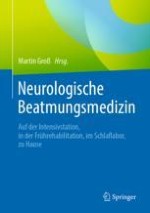Zusammenfassung
Atmung und Atemregulation sind für das Überleben der Tiere und des Menschen unabdingbar. Atemregulation ist ein hochkomplexes, lebenserhaltendes System, das kontinuierlich verschiedene Aufgaben miteinander abstimmen muss: Aufrechterhaltung des Gasaustauschs durch Steuerung von Inspiration und Exspiration, Anpassung der Atmung an die besonderen Erfordernisse bei körperlicher Aktivität, Sicherung des Atemwegs durch Koordination der Atmung mit Schutzreflexen wie Schlucken, Würgen, Husten und Niesen, Koordination der Atmung mit anderen Reflexen wie Gähnen, Koordination der Atmung mit Willküraktivitäten wie Sprechen, Pfeifen, Singen und Spielen von Instrumenten, Auswirkungen von Schmerz, Emotion, Körpertemperatur und Schwangerschaft auf die Atmung, Adaptation der Atmung an den Schlaf-Wach-Rhythmus. Störungen der Atemregulation sind häufig und bleiben in vielen Fällen unerkannt. In diesem Kapitel werden die beatmungsmedizinisch bedeutsamen Grundlagen der Neuroanatomie, Physiologie und Pathophysiologie der Atemregulation sowie die komplexe Interaktion von Atmung und Schlaf erörtert.
